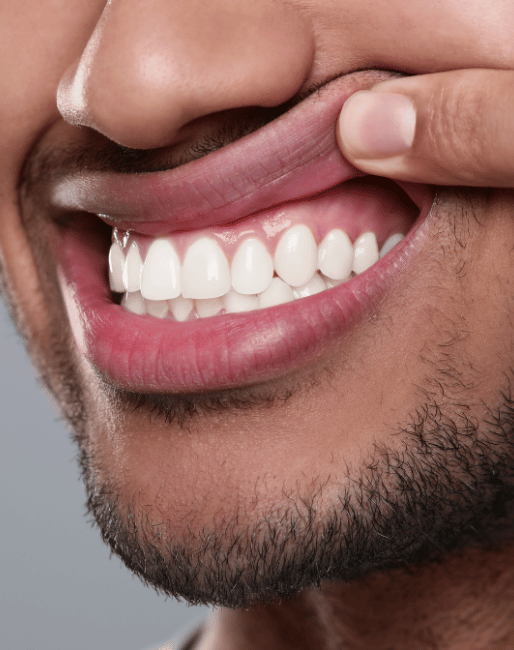If you have a weak tooth or are missing one or more teeth, you may need a crown or a bridge.
A crown sits over a tooth that may have been broken or weakened and serves to return the tooth to its former strength and natural shape. If you are missing one or more teeth, a bridge may be fitted to stop the surrounding teeth from moving out of place and will be anchored by one or more crowns to restore appearance and function.
Dental caps are exactly the same as crowns and bridges and are the more commonly used term amongst the general public. Dental caps are often spoken about in the media; however, the official term is a crown or a bridge, so you will be unlikely to find any dentist referring to them as caps!
Dental crowns for front teeth
When we make crowns for your front teeth, generally speaking, appearance is the most important factor. One of the problems that is faced with dental crowns is finding a material that is strong and resilient enough to last in the oral environment with the constant impact and use that your teeth get.
The issue is one of the transmission and reflection of light through the dental crown. We need to use a material that exhibits the same transmission and reflection of light as a natural tooth; if we do not, then the crown will look different from its surrounding natural teeth.
In years past, gold alloys were used for dental crowns. The existing tooth was reduced down to a stump, a gold alloy thimble was made over the top, and then highly aesthetic dental ceramic was applied to make the crown look like the natural teeth. This technique is still used extensively today, and the results are often excellent.
The problem with this type of porcelain fused to a metal crown is, again, one of the transmission and reflection of light; clearly, light cannot pass through the metal, so it is reflected back. This has the tendency to make the crown look brighter. It certainly is possible to make this type of crown look fantastic. However, a highly skilled dental technician is always required to work closely with the dentist to ensure that the result is perfect.
In more recent years, metal-free crowns have become more popular, especially with the advent of materials like zirconia, which are used extensively in general surgery for the replacement of hips. Zirconia crowns can often be more expensive to manufacture than porcelain fused metal crowns, and some research shows that they may not be quite as resilient.
However, overall, all metal-free crowns are far better to use in the front teeth area due to their natural light-reflecting and transmitting properties, which make them similar to natural teeth.
Dental crowns procedure
The procedure for making a dental crown would normally be as follows:
- An initial diagnosis is made that you need to have a broken-down tooth restored.
- The remaining tooth structure will be reduced to a stump, known as a ‘preparation’. An impression of this preparation will then be taken and sent to the dental laboratory.
- The new dental crown is then fitted approximately 2 weeks later. Each of these steps requires a separate appointment, so the whole process can take four or five weeks from start to finish.
Of course, each dental practice and dentist in London will have a slightly different procedure for their dental crowns. However, they will all have at least the minimum steps laid out above.
Problems with dental crowns
As dental crowns have been in common use since the 1960s, they have had a considerable amount of research, testing, and trialling and have proved themselves over and over to be an excellent choice for restoring a broken tooth. Dental crowns can be problematic in the following areas:
- Aesthetic problems (the way they look).
- Functional problems (the way they work with your surrounding teeth and jaw).
- Longevity (the length of time they last).
Aesthetic and functional problems with dental crowns can almost always be noticed at the initial fitting stage. So when you go to the dentist and have a crown fitted, you need to make sure that it is comfortable with your surrounding teeth and blends in, looking great. Once the crown is fitted, it is often almost impossible to remove it again, so this really is the opportunity for you to tell the dentist your honest opinion.
The longevity of dental crowns is down to the precision of their original manufacture and your ability to look after your teeth. You need to continue to brush your teeth and floss between them, taking special care to ensure that the tooth/crown margin is kept clean.
Lines on dental crowns: why does this happen?
The secret to hiding this grey line is to have either a metal-free crown or for the dentist to be especially careful about how he prepares the tooth to accept the crown, ensuring that no metal is showing.
Many people say that they do not want a dental crown due to the grey line that is often noticeable. This grey line is caused by two things:
- Underlying metal is shown.
- A shadow from the crown cast over the gum area.
However, even if the dentist designs the crown like this in the first place, with any metal hidden underneath the gum, as you get older, your gum has a tendency to resorb and pull away from the teeth-this can mean that over time, any metal edge to a crown becomes more visible. We suggest you discuss this with your dentist prior to having your crown manufactured.











